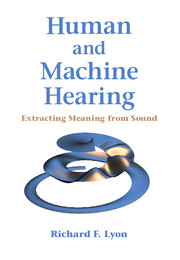Book contents
- Frontmatter
- Dedication
- Contents
- Foreword
- Preface
- Part I Sound Analysis and Representation Overview
- 1 Introduction
- 2 Theories of Hearing
- 3 On Logarithmic and Power-Law Hearing
- 4 Human Hearing Overview
- 5 Acoustic Approaches and Auditory Influence
- Part II Systems Theory for Hearing
- Part III The Auditory Periphery
- Part IV The Auditory Nervous System
- Part V Learning and Applications
- Bibliography
- Author Index
- Subject Index
- Plate section
4 - Human Hearing Overview
from Part I - Sound Analysis and Representation Overview
Published online by Cambridge University Press: 28 April 2017
- Frontmatter
- Dedication
- Contents
- Foreword
- Preface
- Part I Sound Analysis and Representation Overview
- 1 Introduction
- 2 Theories of Hearing
- 3 On Logarithmic and Power-Law Hearing
- 4 Human Hearing Overview
- 5 Acoustic Approaches and Auditory Influence
- Part II Systems Theory for Hearing
- Part III The Auditory Periphery
- Part IV The Auditory Nervous System
- Part V Learning and Applications
- Bibliography
- Author Index
- Subject Index
- Plate section
Summary
On the zigzagging road towards wisdom about the human auditory system we collect knowledge from two entirely different sources of experimental information. First, from anatomy and physiology … Secondly, from perception and psychoacoustics … Our ever wondering mind tries to combine and to explain these findings in terms of some model, law, hypothesis or theory.
—“The residue revisited,” J. F. Schouten (1970)Human versus Machine
Our approach throughout the book is to describe human hearing via machine models. Much of the hearing research field takes a different approach. A huge amount of experimental data has been amassed by auditory psychologists and physiologists, along with a variety of theories, hypotheses, descriptions, and explanations of the data. In this chapter, we attempt to frame this knowledge, to summarize some of the history of attempts to model and explain it, and to connect it to our machine models. We believe that the true test of our “wisdom about the human auditory system” will be the success of our models in replicating important features and functions of hearing, not just in controlled experiments, but in successful applications that process real-world sound mixtures.
The particular problem that Schouten focused on was pitch perception, which has been one of several key problems in hearing, including early studies of music as illustrated in Figure 4.1. Pitch is probably the single most important problem in leading to the auditory image approach to machine hearing. We review pitch and several other aspects of human hearing in this chapter.
Auditory Physiology
Most of what is known about human hearing is either from psychophysical experiments, or extrapolated from physiology experiments on animals. Cats, gerbils, guinea pigs, ferrets, and other laboratory animals have been extensively studied, and we have reason to believe that what we learn from them extrapolates well across other mammals.
Early studies of auditory evoked potentials, electrical signals picked up by electrodes in or near the cochlea or various nerves or brain structures, played a big role in theories of hearing.
- Type
- Chapter
- Information
- Human and Machine HearingExtracting Meaning from Sound, pp. 46 - 77Publisher: Cambridge University PressPrint publication year: 2017



